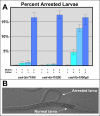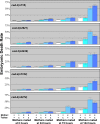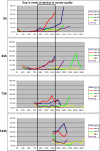Apoptosis maintains oocyte quality in aging Caenorhabditis elegans females
- PMID: 19057674
- PMCID: PMC2585808
- DOI: 10.1371/journal.pgen.1000295
Apoptosis maintains oocyte quality in aging Caenorhabditis elegans females
Abstract
In women, oocytes arrest development at the end of prophase of meiosis I and remain quiescent for years. Over time, the quality and quantity of these oocytes decreases, resulting in fewer pregnancies and an increased occurrence of birth defects. We used the nematode Caenorhabditis elegans to study how oocyte quality is regulated during aging. To assay quality, we determine the fraction of oocytes that produce viable eggs after fertilization. Our results show that oocyte quality declines in aging nematodes, as in humans. This decline affects oocytes arrested in late prophase, waiting for a signal to mature, and also oocytes that develop later in life. Furthermore, mutations that block all cell deaths result in a severe, early decline in oocyte quality, and this effect increases with age. However, mutations that block only somatic cell deaths or DNA-damage-induced deaths do not lower oocyte quality. Two lines of evidence imply that most developmentally programmed germ cell deaths promote the proper allocation of resources among oocytes, rather than eliminate oocytes with damaged chromosomes. First, oocyte quality is lowered by mutations that do not prevent germ cell deaths but do block the engulfment and recycling of cell corpses. Second, the decrease in quality caused by apoptosis mutants is mirrored by a decrease in the size of many mature oocytes. We conclude that competition for resources is a serious problem in aging germ lines, and that apoptosis helps alleviate this problem.
Conflict of interest statement
The authors have declared that no competing interests exist.
Figures








References
-
- Eichenlaub-Ritter U. Genetics of oocyte ageing. Maturitas. 1998;30:143–169. - PubMed
-
- te Velde ER, Pearson PL. The variability of female reproductive ageing. Hum Reprod Update. 2002;8:141–154. - PubMed
-
- Hodges CA, Revenkova E, Jessberger R, Hassold TJ, Hunt PA. SMC1beta-deficient female mice provide evidence that cohesins are a missing link in age-related nondisjunction. Nat Genet. 2005;37:1351–1355. - PubMed
-
- Lamb NE, Sherman SL, Hassold TJ. Effect of meiotic recombination on the production of aneuploid gametes in humans. Cytogenet Genome Res. 2005;111:250–255. - PubMed
-
- Morita Y, Tilly JL. Oocyte apoptosis: like sand through an hourglass. Dev Biol. 1999;213:1–17. - PubMed
Publication types
MeSH terms
Substances
LinkOut - more resources
Full Text Sources
Other Literature Sources
Medical

